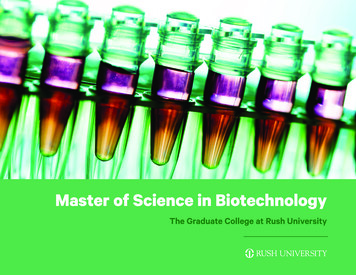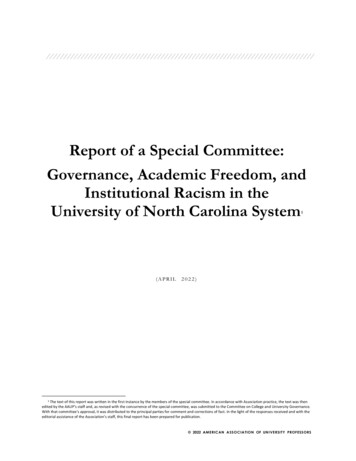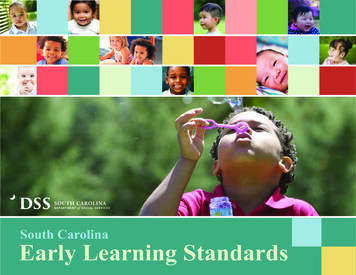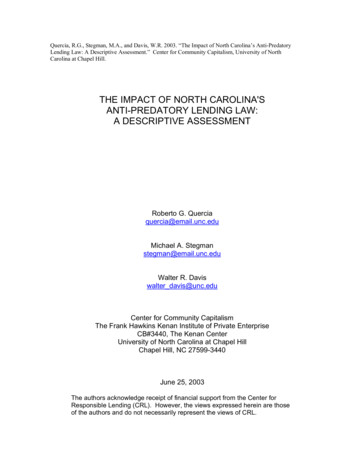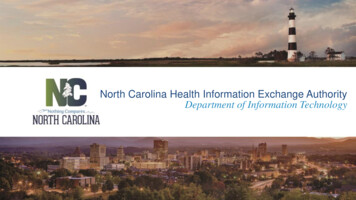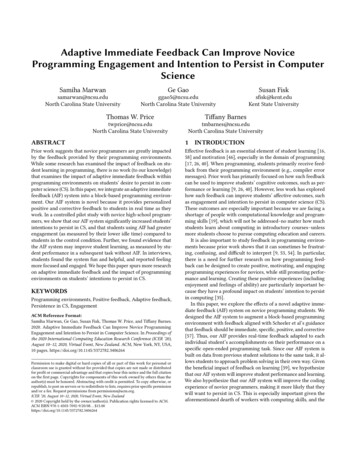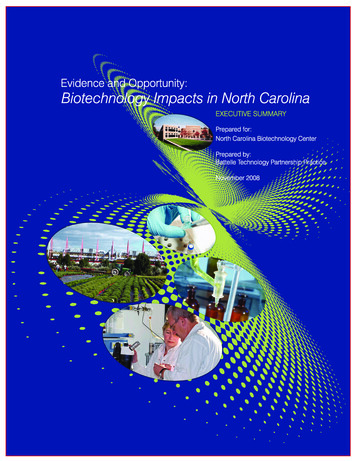
Transcription
Evidence and Opportunity: Biotechnology Impacts in North CarolinaBattelle Memorial Institute (Battelle) does not endorse or recommend particular companies, products, services,or technologies nor does it endorse or recommend financial investments and/or the purchase or sale of securities.Battelle makes no warranty or guarantee, express or implied, including without limitation, warranties of fitnessfor a particular purpose or merchantability, for any report, service, data or other information provided herein.Copyright 2008 Battelle Memorial Institute. Use, duplication, or distribution of this document or any partthereof is prohibited without the written permission of Battelle Memorial Institute. Unauthorized use mayviolate the copyright laws and result in civil and/or criminal penalties.
Evidence and Opportunity: Biotechnology Impacts in North CarolinaSTUDY HIGHLIGHTSIndependent analysis performed by the Battelle Technology Partnership Practicefinds the North Carolina Biotechnology Center to be a successful and criticallyimportant component in North Carolina’s biotechnology growth. Starting fromnascent beginnings 25 years ago, the Center has contributed leadership and awell-structured series of strategic programs that have helped the state becomeone of the preeminent global locations for biotechnology research and production.overly dependent on the fortunes of any singlebiotechnology industry and it is well distributedacross the state.Biotechnology: An EconomicEngine for the StateThe North CarolinaBiotechnology CenterThe size and scope of positivebiotechnology impacts on the state aresignificant: The biotechnology sector in North Carolinadirectly employs 53,200 workers, generatesan additional 127,000 jobs in the statethrough the multiplier effect, for a totalemployment impact of over 180,000 jobs.Over 9.4 billion in North Carolinians’wages and salaries is generated by biotech. Biotechnology generates 45.8 billion intotal North Carolina business volumeand 1.44 billion in state and local taxes.Technology based economic development,which includes biotechnology based economicdevelopment, isAnnual Impacts in Northamong the mostCarolina Generated bychallenging ofBiotechnologyeconomic180,007 jobsactivities. Success 9.4 billion in employmentrequires attentioncompensationto detail along a 45.8 billion in Northcomplex chainCarolina business volumecomprising basic 1.44 billion in taxesgenerated for state andscience, appliedlocal government.science,commercialprototyping, new business formation, andongoing business development. In addition, theright workforce, risk capital resources,infrastructure and support programs have to bein place to reinforce the chain. Few places in theworld have paid attention to detail in buildingthis chain the way North Carolina has.Unlike many other states, North Carolinahas also managed to build a diversebiotechnologybusiness base—Current “PortfolioCompanies” of the Northa base that is notCarolina BiotechnologyoverlyCenter generate thedependent onfollowing impacts:any one3,734 jobssubsector of 193 million in employmentbiotechnologycompensationand bioscience. 818 million of NorthAs such, theCarolina business volumestate’s 26.8 million in state andlocal taxes generated.biotechnologybase is notThe North Carolina Biotechnology Centerhas clearly generated a comprehensive and wellthought-out series of programs and initiativesthat support every link in the developmentchain. Battelle has assessed the functionalprograms of the Center and finds that thei
Evidence and Opportunity: Biotechnology Impacts in North Carolinaprograms of the Center cover all key biosciencedevelopment bases in: Building the scientific research base andassociated development activities; Commercialization of bio-innovations intonew and expanding businesses for NorthCarolina; Supporting recruitment, retention andexpansion of successful biotechnologyemployers, and Supporting education at all levels and thedevelopment of a world-class workforcemeeting the needs of the biotechnologysector.A High Yield Investment forNorth CarolinaThere is little doubt that the NorthCarolina Biotechnology Center represents asuccessful high-yield investment for the state.State financial support for the Center totaled 15.6 million for the current fiscal year. By justone measure, “state and local taxes generated”Battelle finds that current Center portfoliocompanies (companies in which the Center hasinvested funds) return 26.8 million in annualtaxes to North Carolina government—morethan covering the budget for the Center. Thisonly constitutes a small part of overall returnconsiderations, however, which should take intoaccount the fact that, with the help and supportof the North Carolina Biotechnology Sector,biotechnology has grown to produce 45.8billion in annual North Carolina businessvolume, and generate 180,007 jobs in the stateand 1.44 billion in annual state and localgovernment taxes.Throughout the process of conducting thiseconomic impact analysis, Battelle met one-onone with many biotechnology company leadersand stakeholders and conducted quantitativesurveys with these groups. The feedbackreceived from those in the frontlines ofbiotechnology R&D and business developmentin the state overwhelmingly shows that theCenter has been, and will continue to be, acritically important driver of biotechnologysuccess in the state. Some key highlights fromthe surveys reinforce this: The North Carolina Biotechnology Centerhas been a good investor of funds provided to itby the state. Companies that have been fundedby the Center have been able to match theirCenter funds by a ratio of 99:1—attracting 99in additional external funding, usually fromprivate risk capital sources, for every 1 initiallyfunded through the Biotechnology Center.84 percent of stakeholders surveyed saythey are “satisfied” or “very satisfied” withthe Biotechnology Center as a generator ofpositive impacts for the bioscience andbiotechnology sectors in the state.The support provided by the Center forfaculty recruitment has helped attract 52 highprofile bioscience faculty into the state, whoagain have rewarded this investment by bringingin 363 million in external research funds (a 37:1leverage). Today, the total academic bioscienceresearch base in North Carolina is bringing in 1.31 billion from external research sponsorsand generating its own powerful impacts for thestate—over 20,900 jobs, 2.46 billion inbusiness volume, 939 million in employmentincome for North Carolinians and 106.3million in state and local government taxes.87 percent of stakeholders rate the return oninvestment the state receives through fundingto the Center to be “good” or “very good.”One of the stakeholder survey respondentsexpounded on these opinions, noting that:“I have worked in several states and know afair amount about the biotech industry/education inothers. One thing I believe is true: North Carolinaalmost certainly has the most well thought-out,coordinated biotechnology effort in the nation. Ireally don’t think anyone does it better and I’mreferring to far more populous, wealthier stateslike Massachusetts and California. The NCBCdeserves a lot of credit for this.”ii
Evidence and Opportunity: Biotechnology Impacts in North CarolinaA Bright Future for North CarolinaIn the 21st Century, which many havetermed the BioCentury, biotechnology isexpected to be a key engine of economic growthin the United States. Battelle’s analysis finds thatNorth Carolina is well positioned to experiencesubstantial further growth and developmentfrom biotechnology. North Carolina is alreadyranked third among U.S. states in biotechnologycompanies and is significantly outpacing allother leading states in terms of new biotech jobcreation (growing 18.5 percent since 2001).Among its peer states from Maryland to Florida,along the eastern seaboard, North Carolina isleading the way with the highest biotechnologylocation quotient (a measure of industryspecialization), high levels of employment and astrong rate of growth.emphasis on the large-scale economicopportunities coming out of agriculture,agbiosciences and agricultural andenvironmental biotechnology. These fastgrowing areas of biotechnology will leverageNorth Carolina’s green assets to produce manynew business development opportunities in biofuels, bio-based chemicals, bio materials andnatural products.Moving forward the future looks bright,with 63 percent of the biotechnology companiessurveyed during the project noting that theyexpect to increase their North Carolinaemployment over the next decade.Building on its existing 25 year legacy ofbiotechnology development and growth, theCenter has recently rolled out multiple newinitiatives and is preparing several more.Attention to diffusing bioscience andbiotechnology jobs and investment across thestate is being reinforced by the opening of fiveregional offices of the Biotechnology Center (inaddition to the Center HQ at RTP). Newprograms have been launched to further thedevelopment of specialized biotechnologysectors through Centers of Innovation in marinebiotechnology, advanced medical technologies,nanobiotechnology and naturalbiotechnology/integrated medicine—sectorswhich likewise hold promise for diffusestatewide opportunities. The North CarolinaBiotechnology Center is also placing a specialNorth Carolina is recognized as a successstory in biotechnology-based economicdevelopment. Indeed, other states, such asMaryland are modeling their biotechnologydevelopment programs on the work of NorthCarolina. Battelle concludes, however, thatNorth Carolina’s success story in biotechnologyis far from completely written. Moving forwardnew innovations across a wide range ofbioscience and biotechnology areas are going tocreate major opportunities for additionalbiotech growth in the state. With the NorthCarolina Biotechnology Center, Battelle believesthat the state has a critically important asset forassuring North Carolina sustains and expands itsleading-edge growth in biotechnologyinnovation, employment and economic impact.iii
Evidence and Opportunity: Biotechnology Impacts in North CarolinaIn the 21st Century, which many have termed theBioCentury, biotechnology will be a key engine ofeconomic growth in the United States. Majoradvancements are taking place on a host ofbiotechnology fronts, ranging from high precisionpersonalized human biomedical applications throughto widespread biomass-based innovations inagbioscience, bioenergy and industrial biotech.
Evidence and Opportunity: Biotechnology Impacts in North CarolinaEXECUTIVE SUMMARYof the state and multiple stakeholder partners incommitting to biotech as a signature for theNorth Carolina economy.The State of North Carolina was the firstU.S. state to recognize the groundbreakingeconomic development opportunities thatmodern biotechnology would bring. In 1984,the state developed a unique model forbiotechnology development, centered on theformation of the North Carolina BiotechnologyCenter. The Center represented the worlds-firstgovernment sponsored commitment to targetedbiotechnology-based economic development.The state recognized the nascent opportunitieson biotech’s horizon and stepped forward toinitiate the long-term commitment of resourcesrequired to place North Carolina among thepreeminent locations in the world forbiotechnology sector growth. As this reportshows, the results achieved for the benefit ofNorth Carolina and its citizens have beensignificant and are a testimony to the foresightExecutive SummaryThe development of biotechnology inNorth Carolina is clearly a success story andstands as visible testimony to the positive effectsof long-term economic development strategyimplementation. The North CarolinaBiotechnology Center has been a keycontributor to the State’s success, but to-date aformal evaluation of the contributions of theCenter to sector growth and economic impactshas not been fully undertaken and released. Tothis end, the Center retained the independentanalytical services of the Battelle TechnologyPartnership Practice to complete a quantitativeand qualitative review of the economic impactsgenerated by the Center.1
Evidence and Opportunity: Biotechnology Impacts in North CarolinaThe World of BiotechnologyAt the simplest level biotechnology is thescience of using living things, and componentsof living things, to produce goods and services.A more modern definition would say that it alsoinvolves manipulating and modifying organisms,often at the molecular level, to create new andpractical applications and products foragriculture, medicine and industry.GREEN BIOTECHNOLOGY is biotechnologyapplied to agricultural and environmentalprocesses. Examples in agriculture include thedesigning of transgenic plants to enhance yield,improve quality, maintain disease or pestresistance or be better adapted to environmentalstresses. In environmental applications anexample would be the engineering ofmicroorganisms to digest environmentalpollutants and contaminants.While many people associatebiotechnology with the production of humanmedical therapeutic products, the globalbiotechnology sector is far broader. It actuallyencompasses four primary “realms”:BLUE BIOTECHNOLOGY is biotechnologyinvolving marine or aquatic biological products.Examples include marine sourced genes,biopharming via aquatic organism pathways andthe marine production of algae and other biomassresources for industrial applications.RED BIOTECHNOLOGY is biotechnology usedfor medical applications. Some examples are thedesigning of organisms to produce antibiotics,development of genetics-based diagnostics fordisease, or the development of replacementtissue and organs.Increasingly, as in other areas of science,discoveries and advancements are occurring atthe intersection of these four biotechnologyrealms. Plants and animals, for example, arebeing used as production vessels for generatingmedicinal chemicals and tissue (biopharming),while agricultural crops are being engineered tofeed industrial processes in the production ofbio-fuels and bio-renewable chemical products.Figure ES-1 illustrates the three biotechnologyrealms and some of the notable areas of scienceoccurring in their convergence zones.GREY BIOTECHNOLOGY is biotechnologyapplied to industrial processes. Examplesinclude organisms and biological processesdesigned to produce useful chemicals, fuels, orfiber-based materials.Figure ES-1: Macro Biotechnology Clusters and Convergence Areas—A World of OpportunityExecutive Summary2
Evidence and Opportunity: Biotechnology Impacts in North CarolinaBiotechnology promises solutions to manyof the leading challenges the world faces.Consider some of the most pressing globalissues and it is easy to see the important rolebiotechnology will play in addressing thoseissues (Figure ES-2):grow to over 9 billion by 20401, sustaininggrowth in food production is of singularimportance to human life. Every day morethan 860 million people go hungryworldwide.2 Agbiosciences and associatedbiotechnologies focus directly on findingsolutions to this problem.Figure ES-2: Issues and Biotechnology SolutionsLarge ScaleGlobal IssuesBiotechSolutionsHuman HealthDrugs, Therapeutics,Vaccines, Diagnostics,TissueFood SecurityHigh Yield Crops, Diseaseand Pest Resistant Crops,Food Animal HealthRenewableResourcesBio-fuels, nmental Remediation,Global Climate Protection,Environmental ProtectionEconomicGrowthInnovation, CommercialDiscoveries, BusinessGrowth Biotechnology is thus positioned at a uniquetime in history—a time during which aconvergence of new scientific and technologicalcapabilities can be brought to bear to addressissues that may make or break the quality of lifeon Earth. Biotechnology R&D, education andproduction activities are directly relevant topressing issues and opportunities in: Human Health – Biotechnology is afundamental driver in the development ofnew drugs and biotherapeutics, new toolsfor disease diagnostics, vaccinedevelopment, genetic therapies, tissuegrowth, organ engineering, and personalizedmedicine. Also, whether by natural orterrorist means, the threat of major diseaseoutbreaks and food contamination events isa real and present danger—biotechnologypromises solutions to these threats.U.S. Bureau of the Census. “World PopulationInformation.” Online tml2 Food and Agriculture Organization of the UnitedNations. “State of Food Insecurity in the World 2006.”Online m1Food Production and Security – With aworld population of 6.7 billion, projected toExecutive SummaryRenewable/Green Resources andProducts – Linked hand in hand withenvironmental sustainability is an urgentneed for the development of ecologicallybenign resources for economic activity.Biotechnology and associated disciplinesprovide the expertise and resources requiredto develop biorenewable, biomass-basedmaterials and products that will contributeto a sustainable, non-polluting future. Withglobal fossil fuel energy prices at recordlevels, and legitimate concerns relating tocarbon emissions from fossil fuels, the raceis on to develop renewable energy sourceswith nominal environmental impacts.Biofuels have a substantial role to play inthe future of global energy supply.3
Evidence and Opportunity: Biotechnology Impacts in North Carolina providing opportunities within overlappingtechnology convergence zones.Environmental Sustainability –Sustaining population growth and economicgrowth must be balanced with preservationof natural resources and environmentalassets. The 20th Century sawunprecedented growth in pollution, naturalresource depletion and environmentaldegradation. Biotechnology researchers areon the front lines of environmental qualityand sustainability R&D.Three decades of biotechnology growth indistinct geographic locations have led to theconclusion that the sector is characterized by aninteresting geographical characteristic—atendency to cluster. Battelle’s TechnologyPartnership Practice concurs with this and seesclustering occurring at the intersection of threedynamic forces: TECHNOLOGY, TALENTand CAPITAL.Economic Growth – Each of the solutionareas outlined above represent outstandingopportunities for major biotechnologysector growth. Biotechnology is aknowledge-based, high technology field—promising particular growth opportunitiesfor developed economies such as those ofthe United States and North Carolina.Figure ES-3: Macro Factors in Cluster DevelopmentThe need for science-based, innovativesolutions to these challenges is clear and themarket for such solutions of unprecedentedscale. North Carolina, which has a 25-year headstart on many regions of the nation inbiotechnology development, is poised to realizesignificant value from its biotech investments.The Business of BiotechnologyFor clustering in biotechnology, or anytechnology, to occur each of these three forcesUltimately biotechnology is about usefulproducts brought to the market to meet tangibleneeds, but the process begins with basicscientific discoveries feeding into a translationalresearch infrastructure. It is for this reason thatthe academic and basic research infrastructureof a region seeking success in biotechnology isas important as the industrial infrastructure andbusiness climate required for downstreambiotechnology production success.must be in place and in balance. The lack of anyone of the three, or a major weakness orimbalance in one, will place substantial limits onthe prospects for cluster growth. The role of adedicated cluster development organization,such as the North Carolina BiotechnologyCenter, must be to assure each of these threeforces is present, strong and in balance. Inevaluating the North Carolina BiotechnologyCenter’s impacts on the state, it is thereforeimperative to examine the Center’s activities ineach of these three cluster development areas.What is found, as outlined herein, is that theNorth Carolina Biotechnology Center clearlyrecognized the need to have active programs ineach of these areas and has put in place a quitecomprehensive series of initiatives designed toprovide a balanced environment for biotechcluster growth in North Carolina.The most successful biotechnologylocations will be those that are able to sustainthe full continuum of biotechnology, rangingfrom basic scientific bioscience discoveries,onward into translational and applied research,and ultimately into tangible businessdevelopment and business attraction inbiotechnology production. Into the future theywill also be those locations that possessstrengths in all four biotechnology realms,Executive Summary4
Evidence and Opportunity: Biotechnology Impacts in North CarolinaThe North Carolina Biotechnology CenterThe Center has a pragmatic economic development mission:To provide long-term economic and societal benefitsto North Carolina through support of biotechnologyresearch, business and education.The Center addresses this mission via dedicated attention to six principal goals:1Strengthen North Carolina’s academic and industrial biotechnology research capabilities.2Foster North Carolina’s biotechnology industrial development.3Work with business, government and academia to move biotechnology from research tocommercialization in North Carolina.4Inform North Carolinians about the science, applications, benefits and issues of biotechnology.5Enhance the teaching and workforce-training capabilities of North Carolina’s educationalinstitutions.6Establish North Carolina as a preeminent international location for the biotechnology industry.Work on these goals is accomplished bystaff located at the Center’s headquarters facilityin Research Triangle Park and by staff located atfive regional offices strategically located acrossthe State (see Figure ES-4):Figure ES-4: North Carolina Biotechnology Center Headquarters and Regional Office LocationsExecutive Summary5
Evidence and Opportunity: Biotechnology Impacts in North CarolinaThe Center focuses its work through four primary program areas:Science and TechnologyDevelopment(Bioscience R&D)Supporting the emergence of North Carolina as a leading state for basicand applied scientific R&D focused on fundamental and translationaldiscoveries in biotechnology and its applications.Business and TechnologyDevelopmentSupporting entrepreneurship and new biotechnology business enterpriseformation.Business Recruitment,Retention and ExpansionProactively working to bring new biotechnology and biomanufacturingcompany facilities into the state and providing support services to existingNC biotechnology companies to assure their retention and expansion in thestate. This economic development task also incorporates the provision ofstrategic insight and direction in furthering development of biotechnology inNorth Carolina and building public and key stakeholder awareness of theimportance of the sector to the State’s economic future.Education and WorkforceDevelopmentSupporting biosciences education along the continuum from K-12 educationthrough to post-secondary education and proactive programs in bioscienceworkforce development and incumbent worker training initiatives.Clearly, these four areas of focus for theBiotechnology Center are well matched to thetheoretical technology-based economicdevelopment triad of “technology,” “talent”and “capital” required for scientific innovation,business formation, business growth andexpansion.in missing, a sustainable technology cluster isunlikely to develop.The states and regions in the U.S. whichhave achieved success in technology-basedeconomic development (places such as the SanFrancisco Bay region and Boston) have welldeveloped technology development chains inplace. These technology-based economicdevelopment chains may form naturally overtime (as occurred in Silicon Valley), or they mayresult from dedicated activities of states, regionsand key stakeholders to connect and build linksin the chain to assure such developmenthappens. Figure ES-5 illustrates a basictechnology-based economic development chainand the specific links that need to be in place toform and grow a technology cluster.Economic development is not easy toachieve in general, while technology-basedeconomic development is an even greaterchallenge. For economic development to occuran entire interconnected sequence of positivefactors have to be in place. For development oftechnology-based business sectors the chain offactors is particularly complex and challengingto develop and manage. If any link in the chainExecutive Summary6
Evidence and Opportunity: Biotechnology Impacts in North CarolinaFigure ES-5: Necessary Elements in Technology-Based Economic DevelopmentCluster Formation and GrowthIntegration of existingbusinesses into the cluster,and support for additionalbusiness growth fromthese enterprisesState and privatesector commitment tobuilding robustbase of high-qualityscience and technologyfaculty and supportinginfrastructureCommitment totargeted recruitment(domestic and international)of cluster businessesand supportingbusinessesInvestment in infrastructureand personnel forapplication testing, technologypiloting and scale-up activitiesPresence ofentrepreneursand skilled humancapital for businessstart-upsFacilitation andcoordination ofnetworking andcluster supportactivitiesBusinessAttractionExisting NCBiotechBasicScienceStrong academicresearch communityable to attractcompetitiveexternal grantfundingAppliedR&DPiloting &DemonstrationAcademic researchcommunity and keypartners committed totranslating discoveryinto application and movingit towards commercializationTechnologyTransferNew EnterpriseDevelopmentFinancial andpersonnel commitmentto intellectual propertyprotection, technologytransfer and in-statecommercializationPublic and privatesector risk capital forpre-seed, seed andventure fundingroundsBusinessExpansionInfrastructure andfacilities to housescience andtechnology-basednew and expandingbusiness enterpriseNC BiotechnologyBusiness ClusterEducation andworkforcedevelopment tosupport clusterpersonnel needsGeneration of positivegovernment, regulatoryand business climate tomeet competitivecluster needsLong-term, sustained commitment to development of the cluster by all partiesThe North Carolina Biotechnology Centerhas evolved to either meet or supportdevelopment of each of the key links in thechain. Through funding programs, networkinginitiatives, educational activities and strategicguidance, the Center provides a comprehensiveExecutive Summaryapproach to biotechnology technology-basedeconomic development chain completion andsupport. Figure ES-6 illustrates many of themeans by which the Center builds andreinforces the biotechnology development chainfor North Carolina:7
Evidence and Opportunity: Biotechnology Impacts in North CarolinaFigure ES-6: Supports for Biotechnology Sector GrowthNorth Carolina Biotechnology CenterConnecting the Links in the Development ChainBusinessAttractionSupports for Biotechnology Sector GrowthBasicScienceAppliedR&DPiloting &DemonstrationFUNDING:Biotechnology Research GrantSupports investigators at universities and non-profits.Collaborative Funding GrantSupports post-doc fellows or technicians in university.research laboratoriesFaculty Recruitment GrantAssists with recruitment of top scientific talent to NC.universitiesInstitutional Development GrantProvision of core equipment to be used by six or morefaculty members.Multidisciplinary Research GrantFunding three or more scientists, from differentdisciplines, in collaborative research.Event and Meeting GrantsIn support of scientific and associated meetings andevents in North Carolina.Centers of InnovationMarine Biotechnology, Advanced MedicalTechnologies, Nanobiotechnology, and NaturalBiotechnology/Integrated Medicine.FUNDING:TechnologyEnhancement GrantFunds for movingtechnology towardscommercializationreadiness.Centers of InnovationMarine Biotechnology,Advanced MedicalTechnologies,Nanobiotechnology,and NaturalBiotechnology/Integrated Medicine.Existing NCBiotechTechnologyTransferBATON Program¾Business Accelerationand TechnologyOut-licensingNetwork.¾Recruitment ofentrepreneurialmanagement.BTD PartneringPortalCompanies sharingin-licensing andout-licensing needs.New EnterpriseDevelopmentFUNDING:Company InceptionLoanFunds to supportbusiness start-up.SBIR Bridge LoanSupports Phase ISBIR recipients insustaining technologyDevelopment.NETWORKING:Biotech forums andannual Conference additional events.Links to angel andVC investors.Links to qualifiedservice providers.HUMAN CAPITALEntrepreneurrecruitment andentrepreneurshiptraining.INTELLECTUAL EXCHANGE:Coordination of Scientific Interest Groups¾Bioprocessing and Process Development.¾Plant Molecular Biology Consortium.¾RNA Society of North Carolina.¾Smaller Eukaryotes Group.¾Triangle Virology Association.¾Triangle Immunology Interest Group.¾Atlantic Coast Chromatin Conference.BusinessExpansionNC BiotechnologyBusiness ClusterFUNDING:Strategic Growth LoanBiotech funds matching Angel/VC investments in furtherbusiness development.Small Business Research LoanSupports applied research in further development of products,processes, services or tools.NETWORKING:Biotech forums and annual conference additionalevents.Links to angel and VC investors.INFORMATION RESOURCES:Library, information and resource access andcustom research services.HUMAN CAPITAL DEVELOPMENT – (See SpecificDedicated Graphic)¾K-12 teacher and curriculum support programs.¾Education Enhancement Grants¾Workforce development and incumbent worker programs.PHYSICAL SPACE:Lab space clearinghouse.NCBC Supporting Activities and ProgramsConference Center, Events and Meetings, Statewide Offices, Strategy and Visioning .Through its operations and programs, theCenter provides key services that have built andstrengthened the biotechnology developmentprocess in
A Bright Future for North Carolina In the 21st Century, which many have termed the BioCentury, biotechnology is expected to be a key engine of economic growth in the United States. Battelle's analysis finds that North Carolina is well positioned to experience substantial further growth and development from biotechnology. North Carolina is already

